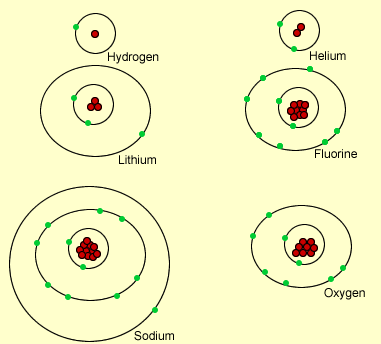
Have a look at the atoms on
the left, there are metal (sodium and lithium) atoms and non-metal (fluorine,
helium, oxygen and hydrogen) atoms.
Lets compare lithium and fluorine. Lithium has one electron in its outer
energy level while fluorine has 7. The distance the outer level (valence)
electrons are from the nucleus is roughly the same for both atoms. However,
the charge that attracts lithium's outer electron to the nucleus is a
single positive charge. You must be thinking, how can this be when there
are three protons in lithium's nucleus. You see, the two electrons between
the outer level electron and the nucleus neutralises the effect of two
protons.
You might wonder, all this talk of attraction between protons and electrons and not one mention of repulsion between electrons and repulsion between protons. Well, there is repulsion between electrons. As electrons move around the nucleus they tend to keep away from one another due to eletrostatic repulsion. In the nucleus where protons are packed in tightly, massive repulsive forces are acting trying to push the protons apart. An even greater force, called the nuclear binding force, holds the nucleus together and prevents it from blowing apart.